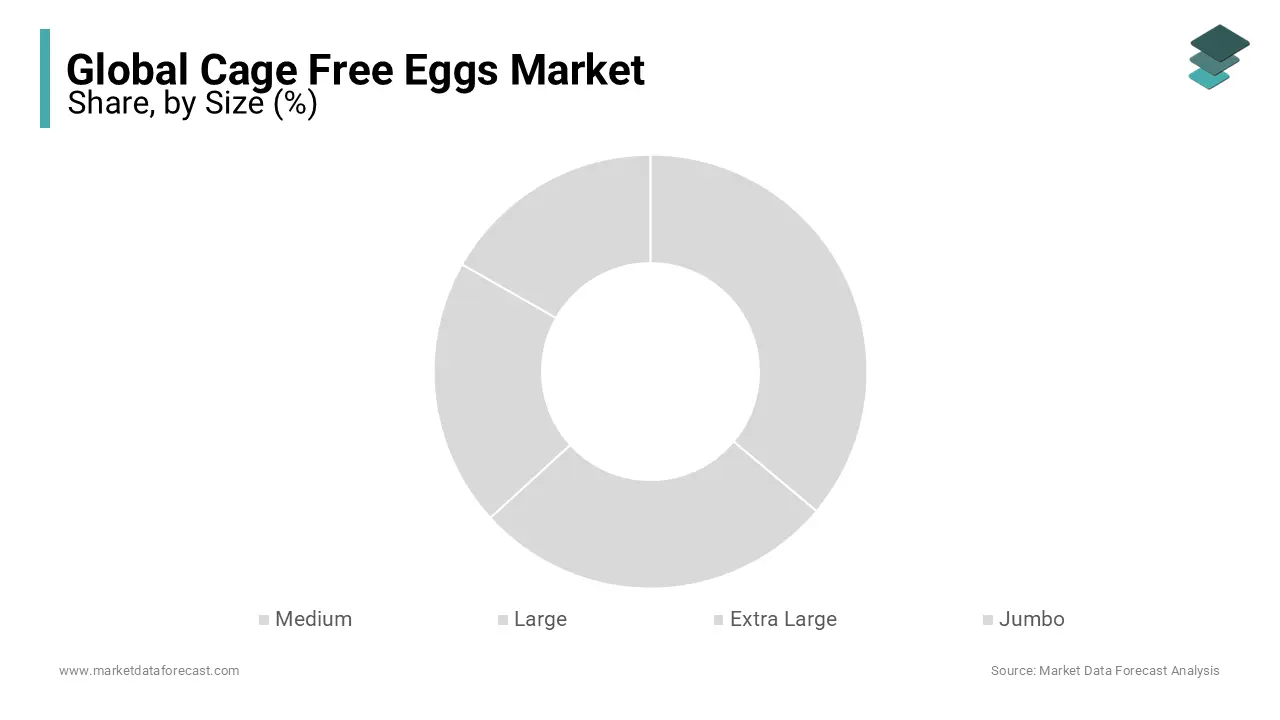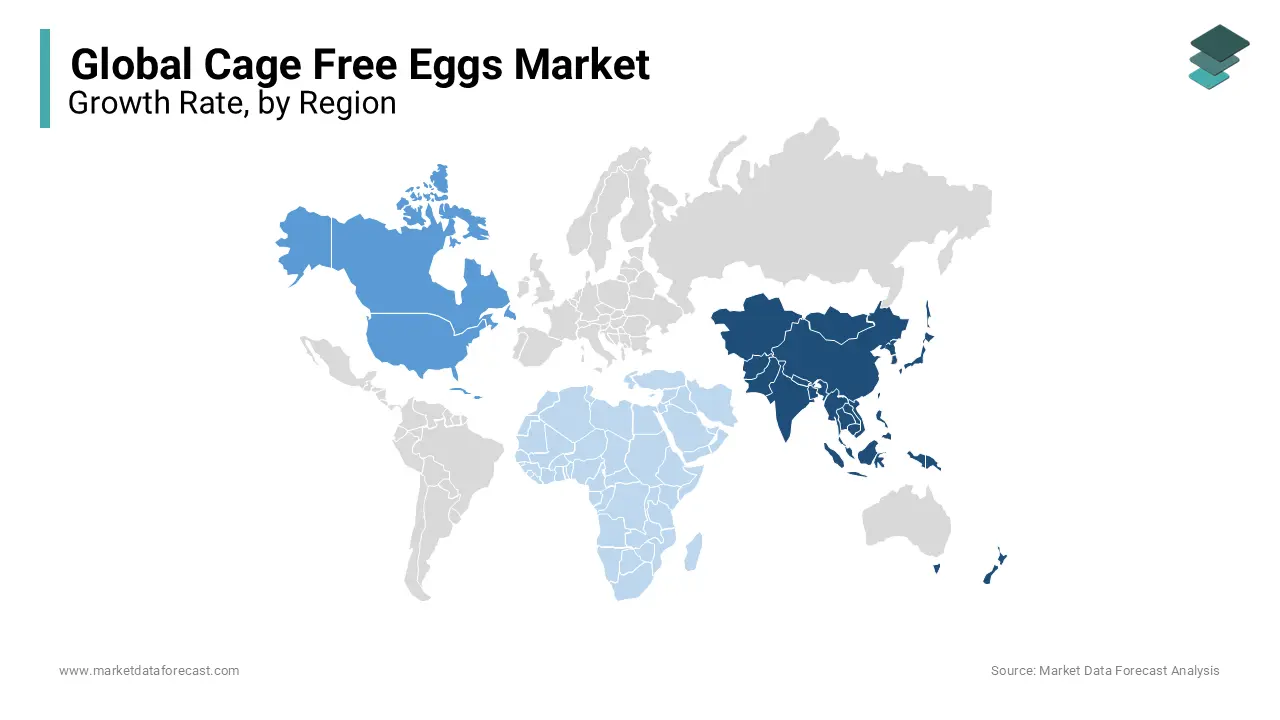Global Cage Free Eggs Market Size, Share, Trends & Growth Forecast Report - Segmented By Colour (Brown And White), Size (Medium, Large, Extra Large And Jumbo), And Region (North America, Europe, Asia Pacific, Latin America, Middle East & Africa, and Rest of the World) - Industry Analysis 2025 to 2033
Global Cage-Free Eggs Market Size
The Global Cage-Free Eggs market size was valued at USD 5.74 billion in 2024, and the global market size is expected to grow from USD 6.01 billion in 2025 to USD 8.68 billion in 2033, with a CAGR of 4.7% between 2025 and 2033.

MARKET OVERVIEW
Cage eggs are a legal term that varies considerably by country of origin. However, cage eggs generally produce a higher yolk and ideally, protect the consumer with nutrient-rich natural products. Cage eggs are a healthier alternative to traditional mass-produced poultry eggs. Cage-free chickens produce omega-3 fatty acids, making the product relevant compared to conventional eggs. Cage eggs are often brown and white in color and are available in different sizes. Increased awareness of the harmful side effects of mass poultry production is leading to increased demand for the cage-free egg market.
MARKET DRIVERS
People's preference to eat organic or naturally made food products to lead healthy lifestyles is attributed to leveraging the growth rate of the cage-free eggs market. The environment for the cage-free hens is different from the conventional farming culture. The laying hens are allowed to move freely here and there in the open indoor spaces. These hens are not caged and are allowed to move in the respective area created for them. Studies show that cage-free hens are more likely to produce high-quality eggs than the hens that are caged. Though the productivity is not equal to the conventional techniques, the quality of the egg produced from laying eggs in open indoor spaces is very high, which substantially elevates the growth rate of the market.
In addition, government support through investments to improve the quality of eggs by producing using traditional techniques with the latest equipment is anticipated to boost the growth rate of the market. The technique involved in producing cage-free eggs is quite similar to the traditional methods, but the laying hens cannot go beyond the area where they can freely move around the place. Increasing prominence to allow the hens to freely spread their wings and lay the eggs in nests, which is a significant option far better than battery cages, is likely to fuel the growth rate of the market during the forecast period. Government authorities are quietly inclined to approve only the caged-free manufacturing process of eggs in order to allow freedom for the hens that can roam freely in open indoor spaces rather than in cages to lay the eggs.
MARKET RESTRAINTS
In addition, the supporting government campaigns for promoting healthy lifestyles for consumers, the rise in overall spending ability of people, the adoption of recent technological advancements in the farms, and other supporting aspects are boosting the whole market boom. Cage-free egg production is very expensive. It involves owning a large tract of land and spending a large sum of money on labor costs. Cage-free chickens occupy a relatively small area in cage production. However, in cage-free production hens, you need free space and the maintenance of an environment to which the hens are accustomed. Producing cage-free eggs should take ten times as much work as caring for chickens that roam naturally on the ground. Due to the freedom given to chickens to walk farms and agroforestry areas, there is a chance of losing chickens, and the eggs they lay are not limited to a particular location. Chickens raised in battery cages are often injected with growth hormones and other supplements and are often provided with nutritious food that is not naturally consumed by chickens. These chickens produce more eggs to meet the daily needs of the market. They are easier to create than Cage eggs, which are produced in smaller quantities and are sold at a much higher price in the retail market. All of these factors are hampering the growth of the global cage-free egg market.
REPORT COVERAGE
|
REPORT METRIC |
DETAILS |
|
Market Size Available |
2024 to 2033 |
|
Base Year |
2024 |
|
Forecast Period |
2025 to 2033 |
|
CAGR |
4.7% |
|
Segments Covered |
By Colour, Size, and Region |
|
Various Analyses Covered |
Global, Regional and Country Level Analysis; Segment-Level Analysis; DROC; PESTLE Analysis; Porter’s Five Forces Analysis; Competitive Landscape; Analyst Overview of Investment Opportunities |
|
Regions Covered |
North America, Europe, APAC, Latin America, Middle East & Africa |
|
Market Leaders Profiled |
Eggland’s Best LLC, Cal Maine Foods, Inc, Herbruck’s Poultry Ranch, Inc, Rembrandt Enterprises, Rose Acre Farms, Hillandale Farms, Trillium Farm Holdings, LLC, Midwest Poultry Services, L.P, Hickman’s Family Farms, Sparboe Farms |
SEGMENTAL ANALYSIS
By Colour Insights
The white segment has an equal share in the cage-free eggs market, whereas the brown segment is likely to have prominent growth opportunities. The brown cage-free eggs are desi-style eggs that are sorted once the hen lays the eggs in the nest. These eggs are then picked and sorted by the person and further sent to sanitization. Many people believe that brown eggs are more naturally laid eggs than white eggs, but the truth is that both are the same in perspective of nutritional value, as there is no evidence to prove that the quality of the egg depends upon size, shape, and color. This factor is likely to enhance the growth rate of the white cage-free eggs market. The production and supply of white eggs have been very high for many years, which is the only reason we usually find more white eggs in stores. However, the quality of the egg completely depends on the hen's health and diet options, where the demand for brown and white cage-free eggs is always high.

By Size Insights
Medium size is gaining more traction over the share of the cage-free eggs market. Medium-sized eggs are more convenient to consume in every household. Consuming eggs on a daily basis has huge health benefits. Where people nowadays are concentrating more on improving their health to avoid the risk of many chronic illnesses, which is carried out to level up the growth rate of the market. On the other hand, large-size eggs are likely to have prominent growth opportunities with the rising usage of eggs in bakeries and other sectors. Eggs play a vital role in the baking industry, and they are likely to leverage the growth rate of the large cage-free egg market.
REGIONAL ANALYSIS
Asia Pacific is ruling with the dominant share of the cage-free eggs market. The high population in emerging countries like India and China is majorly attributed to the growth rate of the market in the Asia Pacific region. China is the most popular country in producing a high number of cage-free eggs as the topmost companies have adopted the new technologies and produced according to the customers' reviews. China's government poses strict action to only produce cage-free eggs according to the norms from the Food and Drug Administration, which is likely to bolster the market's growth rate.

North America is next to Asia Pacific, leading the largest share of the cage-free eggs market. According to the research studies, 22% of Americans will get only cage-free eggs by the end of 2026. In the US, the process of producing eggs through a cage-free process has grabbed huge attention for the past couple of years and is attributed to continuing the same growth rate throughout the forecast period. The rising stringent regulation to allow cage-free laws in various countries is allowed to showcase the wonderful growth opportunities for the market. The cage-free is much more effective in the states of the US, where the demand to produce a high quantity of eggs with new welfare laws is to promote the growth rate of the market.
Europe is deemed to have the highest CAGR by the end of 2033. European countries give more privilege to the naturally produced eggs rather than with the battery caged. Shifting the trend towards the adoption of environmentally friendly procedures in every possible way is likely to outrage the growth rate of the cage-free eggs market in Europe. The rising people's choice of highly nutritious egg quality types like thick and vivid orange yolks accounts for gearing up the growth rate of the cage-free eggs market.
Latin America's cage-free eggs market is expected to have a steady pace over the growth rate in the foreseen years. Though the undeveloped countries in Latin America have been facing an economic crisis for the past two years due to the impact of COVID-19, the share of the cage-free eggs market is likely to rise in the coming years. Key strategies by top companies to expand their business in various countries and conquer their position in the respective marketplace shall showcase huge growth opportunities for the cage-free eggs market in the coming years.
Middle East & Africa are likely to have lucrative growth opportunities in the coming years. The most advanced countries UAE, Saudi Arabia, and others in this region are focusing on raising the eggs productivity in a natural form. These countries are already investing huge amounts in adopting the new changes in the egg productivity channels using the most advanced technologies which is to accelerate the growth rate of the market.
KEY PLAYERS IN CAGE-FREE EGGS MARKET
Key players in CAGE-FREE EGGS MARKET are Eggland’s Best LLC, Cal Maine Foods, Inc, Herbruck’s Poultry Ranch, Inc, Rembrandt Enterprises, Rose Acre Farms, Hillandale Farms, Trillium Farm Holdings, LLC, Midwest Poultry Services, L.P, Hickman’s Family Farms, Sparboe Farms
RECENT HAPPENINGS IN THE MARKET
- In 2025, Cal Maine Foods, Inc. successfully acquired the assets of ISE America Inc., for nearly USD 11o million. ISE America now has the capacity to produce more than 1.0 million cage-free eggs with the best shell egg productivity and processing facilities. These facilities of ISE America Inc. can leverage the product portfolio of Cal Maine Foods, Inc. in various countries.
MARKET SEGMENTATION
This research report on the global cage-free eggs market has been segmented and sub-segmented based on Size, Colour, & region.
By Size
- Medium
- Large
- Extra Large
- Jumbo
By Colour
- Brown
- White
By Region
- North America
- Europe
- Asia Pacific
- Latin America
- Middle-East & Africa
Frequently Asked Questions
1.What are cage-free eggs?
Cage-free eggs come from hens that are not confined to cages and are typically allowed to roam freely within a barn or enclosed area. This environment allows hens to engage in natural behaviors such as perching, dust bathing, and nesting.
2.What are the benefits of cage-free eggs?
Cage-free egg production systems are often perceived as more humane and environmentally friendly compared to conventional cage systems. Hens in cage-free systems have more space and freedom to express natural behaviors, leading to potentially higher welfare standards.
3.Are cage-free eggs more expensive?
Cage-free eggs may be slightly more expensive than conventional eggs due to higher production costs associated with providing hens with more space and enrichment. However, prices can vary depending on factors such as location, production scale, and market demand.
Related Reports
Access the study in MULTIPLE FORMATS
Purchase options starting from $ 2500
Didn’t find what you’re looking for?
TALK TO OUR ANALYST TEAM
Need something within your budget?
NO WORRIES! WE GOT YOU COVERED!
Call us on: +1 888 702 9696 (U.S Toll Free)
Write to us: [email protected]